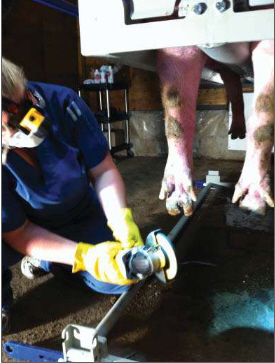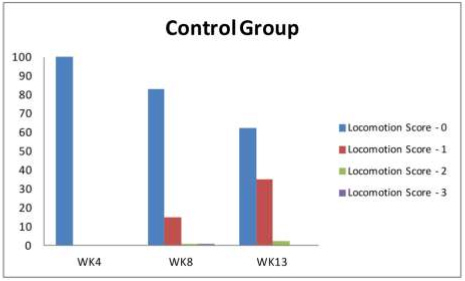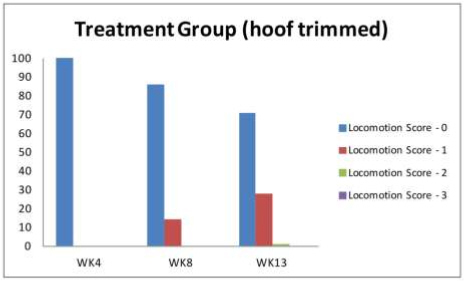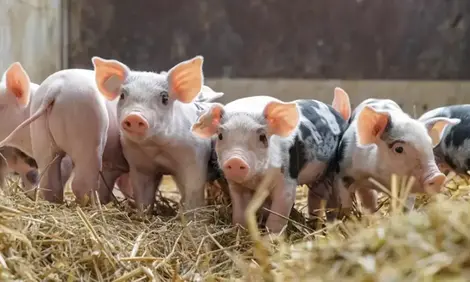



Early Detection and Interventions for Reducing Lameness in Gestating Sows
The prevalence of lameness in sows may be higher than thought, with roughly 50 per cent of low-parity sows being affected in this study, reported by researchers from the Prairie Swine Centre at the Centralia Swine Research Update 2014. They describe corrective hoof trimming, which may help farms manage and reduce lameness.
Summary
Lameness in sows is a painful condition that can affect fertility, mobility, feed intake and culling rate, according to Yolande Seddon and Jennifer Brown of the Prairie Swine Centre.
Methods for the early detection and prevention of lameness have not been studied extensively but if effective, such measures could improve overall herd health, welfare and the productivity of sows.
Poor hoof condition is increasingly believed to be a contributing factor to lameness development.
The objectives of this study were:
- to conduct a survey to assess the prevalence of lameness and hoof condition in a large commercial sow herd
- assess the effectiveness of preventative hoof trimming on reducing the occurrence and severity of lameness, and
- assess the effectiveness of an early intervention treatment, including analgesics, provision of rubber stall matting to aid recovery and a corrective hoof trim, at reducing the prevalence and severity of lameness.
Results to date show that from a survey of 3,286 sows (55 per cent of the herd), almost 60 per cent of sows showed signs of lameness in at least one leg, and a large percentage of sows had multiple hoof lesions.
Although the completion of Objectives 2 and 3 is ongoing, preliminary data suggest that preventative hoof trimming reduces the occurrence and severity of lameness in gestation.
The results so far indicate that true prevalence of lameness on farms is likely to be underestimated.
Introduction
Lameness is a common problem among sows and is believed to be one of the most common reasons for culling.
Prevention and treatment of lameness is of great importance for sow welfare, productivity and overall herd profitability, sows need to remain in the herd for at least three parities before generating a profit, and therefore premature culling of sows results in financial loss. As well, as producers shift to group housing systems, sow mobility will become more important and having options for prevention and treatment of lameness will be of increased benefit to producers.
Methods for the early detection and prevention of lameness in sows have not been studied extensively but would have the potential to reduce veterinary and euthanasia costs and to improve the productivity and profitability of pork production.
Increasingly, along with joint issues, there is evidence suggesting that hoof condition contributes significantly to the development of lameness in sows and gilts.
Currently, there is a lack of knowledge of techniques to prevent or treat lameness. Hoof trimming is commonly used to maintain hoof condition in many hooved species, including dairy cattle, sheep and horses, however it is not commonly performed in pigs.
This study examined the role that corrective hoof trimming has on foot health and lameness using the Feet First® chute. The chute was recently developed by Zinpro Corporation (Minnesota, US), and is designed to safely restrain and lift a sow, allowing examination of the sow’s hooves and completion of a corrective hoof trim. This study used the FeetFirst chute, and is the first examination of its use in a Canadian swine herd.
Experimental Procedures
A 6,000-sow commercial operation was recruited to participate in the study, with the aim of observing incidences of lameness more representative of commercial production than is found in the Prairie Swine Centre’s 300-sow research herd. Sows were stall housed for the duration of gestation.
Objective one: Survey of prevalence, type and severity of lameness
At four weeks gestation, sows were removed from their gestation stalls and lameness was assessed as sows walked on a solid concrete hallway. A trained technician observed the sows as they walked a distance of 20ft, and sows were given a locomotion score in accordance with the Zinpro Feet First scoring system, as follows:
- 0: Sow moves easily with very little inducement. She is comfortable on all four feet.
- 1: Sow moves relatively easily but visible signs of lameness are apparent in at least one leg although it may be difficult to determine which leg is causing the lameness.
- 2: An abnormal gait is observed. Lameness could be observed in one or more limbs. The sows may exhibit compensatory behaviours such as dipping and raising her head in time to foot falls and arching her back.
- 3: An abnormal gait is observed and the affected limb(s) are able to be identified. The sow may be reluctant to bear weight on the affected limb and will avoid using it. Sow will be reluctant to move, and it is difficult to move her from place to place in the barn.
Following the locomotion observation, each sow received a hoof assessment on all four feet.
Each hoof was assessed for hoof wall cracks (both vertical and horizontal), toe length, dew claw length, heel overgrowth and white line cracks. Hooves were scored for each lesion on a scale of 0-3 in accordance with Zinpro’s hoof lesion scoring guide (Table 1).
| Table 1. Zinpro FeetFirst© hoof lesion scoring guide | |||||
| Lesion description | Toes (T) | Dew claws (DC) | White line (WL) | Heel overgrowth & erosion (HOE) | Cracked wall (CW) |
|---|---|---|---|---|---|
| 1 | One or more toes slightly longer than usual | Slightly longer than normal | Shallow and/or short separation along white line | Slight overgrowth &/or erosion in soft heel tissue | No haemorrhage evident, short/shallow crack in wall |
| 2 | One or more toes significantly longer than usual | Claws extend to floor surface when pig is standing | Long separation along white line | Numerous cracks with obvious overgrowth & erosion | Long but shallow crack in wall |
| 3 | Long toes that affect gait when walking | Claw is torn &/or partially or completely missing | Long & deep separation along white line | Large amount of erosion & overgrowth with cracks through out | Multiple or deep cracks in the wall |
A healthy hoof with no sign of lesions was given a score of zero. Any injuries observed (e.g. open wounds, bruising, joint swelling) were also recorded.
The parity of each sow was recorded, and a number of the sows were then selected for objectives two and three of the study.
Objective two: Preventative hoof trimming
A total of 200 non-lame sows (locomotion score 0, as determined in phase one) were allocated to either a treatment group (received a hoof trim at eight weeks gestation), or a control group (received no treatment, observed only), with 100 sows per group.
In addition to the locomotion and hoof lesion scores collected in phase one at four weeks gestation, all sows received a hoof examination at eight weeks gestation using the Zinpro FeetFirst chute (Figure 1). Sows were restrained in the chute and raised off the ground to allow a detailed examination of all four feet.

Sows allocated to the treatment group received a corrective hoof trim (Figure 2), while those allocated to the control group did not.
The goal of the hoof trimming was to restore good conformation to the hoof and to correct the weight distribution and balance. The hoof trimming procedure followed was developed by Zinpro, and conducted as follows:
- Step 1. Reduce toe length: Using nippers, make the toe length of both claws as equal in length as possible. A hand grinder is used to smooth any sharp edges.
- Step 2. Straighten the hoof wall: If the toe has any curve to it, remove excess wall growth and straighten the hoof wall.
- Step 3. Balance the hoof: Balance the sole and the heel of the foot using the grinder on the bottom of the foot to restore normal weight bearing. Any excess heel growth is removed.
- Step 4. Trim the dew claws: Overgrown dew claws should be shortened removing the hoof in gradual steps. A grinder was then used to round off and remove any sharp edges.
All sows were given a second locomotion score at 13 weeks gestation to observe any changes. Following gestation, standard production measures were collected per sow, including the number
of piglets born, live born, stillborn, mummified and weaned.

Objective three: Lameness intervention
Objective three of the study investigated the effectiveness of early intervention (treatment) for
lame sows. Two hundred lame sows (locomotion score 1-3) were randomly assigned to one of the following:
- Early Intervention: Hoof evaluation and trimming, housed on rubber flooring, and administered two NSAID injections (n=100)
- Control Treatment: Hoof evaluation, housed on concrete flooring (n=100)
An additional control group of non-lame sows (given a ‘0’ in the lameness assessment) were also monitored (n=100) for comparison purposes. The data collection for this phase is still ongoing.
Results and Discussion
Objective one: Sow lameness survey
A total of 3,286 sows (55 per cent of the total sow herd) were assessed for locomotion and hoof lesions.
Of the sows surveyed, 40.9 per cent were not lame, 53.2 per cent were mildly lame (a score of 1), 5.7 per cent moderately lame (a score of 2), and 0.2 per cent severely lame (a score of 3), (Figure 3).

Together these results indicate that almost 60 per cent of the herd showing signs of lameness in at least one leg, which is considerably higher has been reported in literature.
Although this study has found an elevated incidence of lameness, there were very few severely lame animals, with only 0.2 per cent (seven sows) having a locomotion score of 3.
The number of sows scoring 1 was very high, however, at this level of lameness the majority of cases may go largely unnoticed by stockpersons, as it can be slight and difficult to pinpoint. The mild nature of early lameness thus contributes to the general underreporting of the problem.
Examining parity differences, between 42 and 59 per cent of sows in parities 0 to 3, were found to be lame. This illustrates a significant problem, and risk, if young parity sows are showing lameness and may be prematurely lost from the herd due to lameness.
Thus identifying effective treatments that can be implemented at this early stage may have a
significant impact.
Concerning the condition and health of the hooves, 80 per cent of sows had a correct toe length, with a score of 0. Long dew claws were prevalent in 67 per cent of sows, and 52 per cent of sows had heel erosion. Wall and white line cracks were less prevalent with 26 per cent and 36 per cent of sows affected, respectively.
There was significant missing data related to heel erosion and white line scores in this phase of the study due to sows being assessed while standing, making it difficult to observe the underside of the hoof, thus these results may not be representative. It is likely that a higher prevalence of these conditions exists than is reported here. The quality of flooring is believed to be strongly
linked to the prevalence of foot lesions.
Objective two: Preventative hoof trimming
Preliminary results suggest that when comparing the control and treatment groups at week 13 of gestation (five weeks after hoof trimming for treatment sows) a greater number of the hoof trimmed sows remained sound (locomotion score of 0), and fewer sows showed increased lameness, compared to sows in the control group (Figure 4).

These preliminary results, comparing trimmed and untrimmed sows, suggest that trimming may be beneficial for preventing the further development of lameness, and for reducing the severity of lameness that does develop.
Data collection is nearing completion for this phase of the trial, and a full analysis is needed before firm conclusions can be drawn. The final analysis will also consider the extent to which hoof lesions are related to lameness.
Conclusions
This study provides detailed results on the prevalence of lameness in a large commercial sow herd. The preliminary results indicate that the prevalence of lameness on the study farm is high, with roughly 50 per cent of low-parity sows being affected.
Observations of hoof condition indicate that hoof lesions, long dew claws and heel erosion are the most common problems.
Previous research indicates that hoof lesions are related to the partially slatted concrete floors on which sows are housed.
The sows in this study were housed in gestation stalls and in this setting, mild lameness may be largely unnoticed.
As producers move to group housing systems for sows, the effects of lameness may be more easily observed, and thus further work to improve management of sows (good nutrition, genetics, flooring and hoof care) to reduce lameness will be of increasing importance to the swine industry.
Corrective hoof trimming may be one option to help farms manage and reduce lameness, with the initial results here suggesting that hoof trimming can reduce the development of lameness.
Acknowledgement: The authors gratefully acknowledge specific project funding for this study provided by Agriculture and Agri-Food Canada’s Canadian Agricultural Adaptation Program, which is managed in Alberta by the Agriculture and Food Council of Alberta. Strategic program funding to the Prairie Swine Centre was provided by Sask Pork, Alberta Pork, Manitoba Pork Council, and the Saskatchewan Agricultural Development Fund..
Reference
Seddon Y. and J. Brown. 2014. Early detection and interventions for reducing lameness in gestating sows. Proceedings of 33rd Centralia Swine Research Update. II-42–II-43.
August 2014








